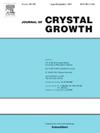用光学行进浮动区法研究掺杂 Ta+Gd 的 TiO2 单晶中巨型介电常数的起源
IF 1.7
4区 材料科学
Q3 CRYSTALLOGRAPHY
引用次数: 0
摘要
共掺杂 TiO2 多晶陶瓷具有显著的介电行为 (>104),但其来源仍未完全阐明。与陶瓷材料相比,单晶体可以保持材料的大部分原始特性,消除晶界和孔隙的干扰,从而有利于探索介电性能的来源。在此,我们选择离子半径适中的 Gd3+ 作为受体离子,Ta5+ 作为供体离子,通过光学游浮区法制备了 (Gd0.5Ta0.5)0.01Ti0.99O2 单晶,研究其巨大的介电性能。研究发现,(Gd0.5Ta0.5)0.01Ti0.99O2 单晶在 105Hz 频率下同时达到了介电常数(ε′∼1.5 × 104)和介电损耗(tanδ∼0.07)。电化学阻抗谱和 XPS 分析表明,高介电性能主要归因于电子钉住了有缺陷的偶极子簇。此外,直流偏压下的介电弛豫行为表明,电极效应也会影响介电常数。这项研究为TiO2基材料中大介电常数的起源和单晶体的生长提供了启示。本文章由计算机程序翻译,如有差异,请以英文原文为准。
Origin of giant dielectric constant in Ta+Gd co-doped TiO2 single crystals by optical traveling floating zone method
The co-doped TiO2 polycrystalline ceramics have dramatic dielectric behavior (>104), but its source is still not completely clarified. Compared to ceramic materials, single crystals can maintain most of the original properties of the material and eliminate the grain boundary and pore interferences, thus facilitating the exploration of the source of the dielectric properties. Here, we chose Gd3+ with a moderate ionic radius as the acceptor ion and Ta5+ as the donor, preparing (Gd0.5Ta0.5)0.01Ti0.99O2 single crystals by the optical traveling floating zone method to investigate giant dielectric properties. It was found that a dielectric constant (ε′ ∼1.5 × 104), and a dielectric loss (tanδ ∼ 0.07) were achieved simultaneously in (Gd0.5Ta0.5)0.01Ti0.99O2 single crystals at 105Hz. Electrochemical impedance spectroscopy and XPS analyses indicate that the high dielectric properties are mainly attributed to electrons pinning defective dipoles clusters. In addition, dielectric relaxation behavior under DC bias suggests that electrode effects also affect the dielectric constant. This study provides insights for the origin of the large dielectric constant and the growth of single crystals in TiO2-based materials.
求助全文
通过发布文献求助,成功后即可免费获取论文全文。
去求助
来源期刊

Journal of Crystal Growth
化学-晶体学
CiteScore
3.60
自引率
11.10%
发文量
373
审稿时长
65 days
期刊介绍:
The journal offers a common reference and publication source for workers engaged in research on the experimental and theoretical aspects of crystal growth and its applications, e.g. in devices. Experimental and theoretical contributions are published in the following fields: theory of nucleation and growth, molecular kinetics and transport phenomena, crystallization in viscous media such as polymers and glasses; crystal growth of metals, minerals, semiconductors, superconductors, magnetics, inorganic, organic and biological substances in bulk or as thin films; molecular beam epitaxy, chemical vapor deposition, growth of III-V and II-VI and other semiconductors; characterization of single crystals by physical and chemical methods; apparatus, instrumentation and techniques for crystal growth, and purification methods; multilayer heterostructures and their characterisation with an emphasis on crystal growth and epitaxial aspects of electronic materials. A special feature of the journal is the periodic inclusion of proceedings of symposia and conferences on relevant aspects of crystal growth.
 求助内容:
求助内容: 应助结果提醒方式:
应助结果提醒方式:


